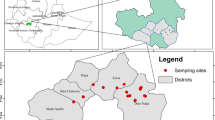Abstract
The data on the content of total and some forms (suspended, labile, and carbohydrate-like) of organic substances in inflowing rivers of the Rybinsk Reservoir are presented. The greater portion of organic substances enters the Rybinsk Reservoir in the form of difficulty decomposable dissolved compounds. The labile fraction accounts for no more than 4.6% of the total amount. The distribution of the total organic substance runoff within a year correlates with the water runoff volume. The quantity of organic substance inflow with each river depends both on the water runoff volume and on the value of mean weighted concentrations of organic substances in water of these rivers. It is suggested that the obtained values should be considered as regional geochemical constants, which may be useful in preparing the total balance.
Similar content being viewed by others
References
Alekin, O.A., Semenov, A.D., and Skopintsev, B.A., Rukovodstvo po khimicheskomu analizu vod sushi (Manual on the Chemical Analysis of Continental Waters), Leningrad: Gidrometeoizdat, 1973.
Bikbulatov, E.S., A Simple Method for Oxidation of Organic Matter for Determining Carbon, Gidrokhim. Mater., 1974, vol. 60, pp. 174–178.
Bikbulatov, E.S., Determination of Carbohydrates in Natural Waters, Gidrokhim. Mater., 1974, vol. 60, pp. 179–185.
Bikbulatov, E.S and Bikbulatova, E.M., Decomposition Rate of Organic Matter of Dead Phytoplankton, in Mikrobiologicheskie i khimicheskie protsessy destruktsii organicheskogo veshchestva v vodoemakh (Microbiological and Chemical Processes of Organic Matter Destruction in Water Bodies), Leningrad: Nauka, 1979, pp. 213–224.
Vinberg, G.G., Pervichnaya produktsiya vodoemov (Primary Production of Water Bodies), Minsk: Vysheisha shk, 1960.
Gosudarstvennyi vodnyi kadastr. Ezhegodnye dannye o rezhime i resursakh poverkhnostnykh vod sushi za 1981 g. (State Water Cadaster. Annual Data on the Regime and Resources of Continental Surface Waters for 1981), Gorky: Verkhnevolzhskoe UGKS, 1983, vol. 1, part 1, p. 487.
Gosudarstvennyi vodnyi kadastr. Ezhegodnye dannye o rezhime i resursakh poverkhnostnykh vod sushi za 1982 g. (State Water Cadaster. Annual Data on the Regime and Resources of Continental Surface Waters for 1982), Gorky: Verkhnevolzhskoe UGKS, 1984, vol. 1, part 1, p. 479.
Kuznetsov, S.I. and Bezler, F.I., Experience in Calculating Organic Matter Balance in the Rybinsk Reservoir, in Biologiya i produktivnost’ presnovodnykh organizmov (Biology and Production of Freshwater Organisms), Leningrad: Nauka, 1971, pp. 66–75.
Larionov, Yu.V. and Skopintsev, B.A., Isolation of Suspended Matter from Natural Water on Silicon Dioxide Powder, Gidrokhim. Mater., 1974, vol. 60, pp. 192–196.
Litvinov, A.S. and Roshchupko, V.F., Variations in Ecosystem Characteristics of the Rybinsk Reservoir in the Context of Climatic Conditions in Its Basin, in Tez. dokl. 6-go Vserossiiskogo gidrologicheskogo s”ezda (Abstracts of Papers, 6 All-Russia Hydrological Congress), St. Petersburg: Gidrometeoizdat, 2004, pp. 241–242.
Mineeva, N.M., Ecological-Physiological Aspects of Formation of Planktonic Primary Production in the Volga Reservoirs, Extended Abstract of Doctoral (Biol.) Dissertation, N. Novgorod: Nizhegorodskii State Univ., 2003.
Romanenko, V.I. and Kuznetsov, S.I., Ekologiya mikroorganizmov presnykh vodoemov (laboratornoe rukovodstvo) (Ecology of Microorganisms of Fresh Water Bodies (Laboratory Manual)), Leningrad: Nauka, 1974.
Rutkovskii, V.I. and Kurdina, T.N., Water Balance of the Rybinsk Reservoir for the Period from 1947 to 1955), Tr. Inst. Biologii Vodokhranilishch, 1959, iss. 1(4), pp. 5–24.
Rybinskoe vodokhranilishche i ego zhizn’ (The Rybinsk Reservoir and Its Life), Leningrad: Nauka, 1972.
Savina, V.D., Water Balance of the Rybinsk Reservoir, in Sb. rabot Gor’kovskoi, Volzhskoi i Rybinskoi gidrometeorologicheskikh observatorii (Collection of Works of Gor’kovskaya, Volzjskaya, and Ryibinskaya Hydrometeorological Observatories), Leningrad: Gidrometeoizdat, 1973, issue 10, pp. 154–174.
Skopintsev, B.A., Organic Matter in Natural Waters (Aquatic Humus), Tr. Gos. Okeanogr. Inst., 1950, issue 17(29).
Skopintsev, B.A. and Bakulina, A.G., Organic Matter in the Water of the Rybinsk Reservoir in 1964, in Produtsirovanie i krugovorot organicheskogo veshchestva vo vnutrennikh vodoemakh (Production and Turnover of Organic Matter in Inland Water Bodies), Leningrad: Nauka, 1966, pp. 3–32.
Fortunatov, M.A., Water Color Index and Transparency of the Rybinsk Reservoir as Characteristics of Its Regime, Tr. Inst. Biologii Vodokhranilishch, 1959, iss. 2(5), pp. 246–357.
Author information
Authors and Affiliations
Additional information
Original Russian Text © E.M. Bikbulatova, I.E. Stepanova, E.S. Bikbulatov, 2006, published in Vodnye Resursy, 2006, Vol. 33, No. 3, pp. 338–348.
Rights and permissions
About this article
Cite this article
Bikbulatova, E.M., Stepanova, I.E. & Bikbulatov, E.S. Forms, quantities, and variability of organic substance inflow into the Rybinsk Reservoir. Water Resour 33, 310–320 (2006). https://doi.org/10.1134/S0097807806030080
Received:
Issue Date:
DOI: https://doi.org/10.1134/S0097807806030080




